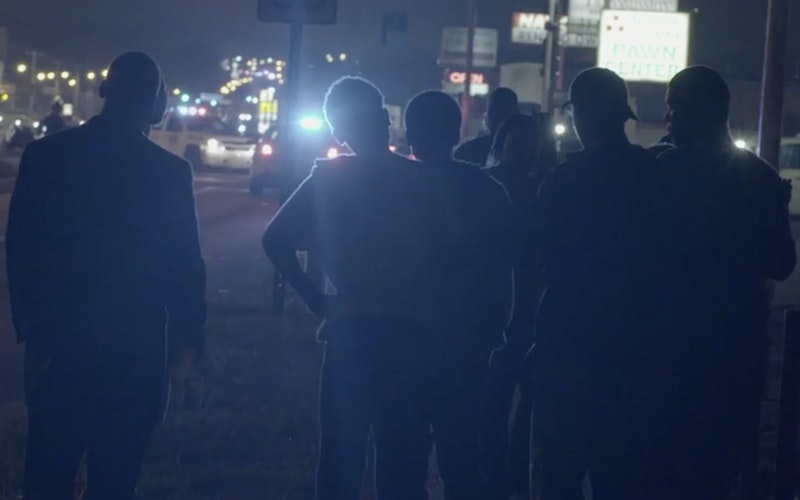
Movies
The Prophetic Witness of Whose Streets?
Hate wins.
It’s tempting to believe that statement to be true after this past weekend in Charlottesville, Va., where a scheduled and approved white-supremacist rally erupted in violence, leaving many injured and one counter-protester dead. Yet as I followed the reports, my mind also turned to Whose Streets?, a new documentary about the uprisings that followed the 2014 police killing of unarmed African-American teenager Michael Brown in Ferguson, Mo. There was hate in Ferguson too, but Whose Streets? also captures its opposite: love.
Talking about his experience in the midst of the Ferguson protests, one unnamed activist said this: “Lot of people didn’t do it justice when they put it in their timeline. Because when you’re in the heart of it, when you get to see the faces, then you feel that black love.”
Directed by Sabaah Folayan and Damon Davis, Whose Streets? puts us in the heart of it. The documentary includes first-person interviews with a handful of activists, but its real power lies in its extensive use of camera-phone video footage, some taken during the hours Brown’s body was left on the street and others from the ensuing days and nights of protests. On one chilling occasion, residents standing behind a chain-link fence are told by law-enforcement officials via loudspeaker to return to their homes. When one of them shouts, “This is my backyard!” they’re fired upon with gas canisters, smoke enveloping the screen. In these immediate, visceral images, we feel the hate that the protestors faced in the form of a massive military presence (dogs, trucks, weapons), one that was notably absent from Charlottesville.
At the same time, we also see flickers of love, as when onlookers gather the wailing mother of Michael Brown into their arms at the scene of his death, or when protesters demanding an inquiry into his killing walk arm in arm, forming a united, sacrificial front in the face of rubber bullets and tear gas. Yes, there was property destruction and looting as well—that’s what most news reports focused on—but Whose Streets? reveals much more than that surface anger. In many ways the documentary is a reminder of Nicholas Wolterstorff's contention that justice and love go hand in hand.
It’s in the seeing and naming that Whose Streets? is prophetic.
After the violent weekend in Charlottesville, though, we have to wonder: is it really possible to protest in love? Can anger and indignation be directed toward good? Perhaps the closest model we have for this is that of Jesus disrupting the marketplace outside the temple—delivering, in the words of New Testament scholar John Dominic Crossan, “a protest from the legal and prophetic heart of Judaism against Jewish religious cooperation with Roman imperial control.” Christ’s actions were prophetic. In the Gospel of Matthew, Jesus quotes both Isaiah and Jeremiah, noting that what God had intended as a “house of prayer” had been transformed into a “den of robbers.”
Prophets and justice have long gone hand in hand. During the Civil Rights Movement, Martin Luther King Jr. stirringly referenced Amos, pledging to “work and fight until justice runs down like water, and righteousness like a mighty stream.” Can something like Whose Streets? be prophetic in a similar way today?
Writing for TC in 2015, in the wake of Ferguson and camera-phone footage depicting the deaths of other black men at the hands of police, Kimberly Davis described the use of camera phones as a “measure of justice,” though “partial, at best.” Whose Streets? captures both the effectiveness and limitations of this technology as a tool for justice. There is much to the story that the footage doesn’t cover, a context and structure that Whose Streets? lacks. Yet there is also a cumulative truth to the images we see, a way for us to experience how a neighborhood was turned, in the words of one activist, into an “unseen war.”
It’s in the seeing and naming that Whose Streets? is prophetic, a stark witness to oppression, a witness that makes room both for Christ’s righteous anger and his unfailing love. “Now, justice and mercy may be taking on a new and different meaning,” Davis wrote for TC in 2015. “It is not simply about criminal justice, although in our system and in our society that is essential and it breaks my heart when it is denied. It is about the knowing. It is about seeing with our own eyes, if we can stand to look at it. It is about the social—how communities come together to protest and reform, to force people to hear us. Finally, to hear and see us.”
Jesus sees and hears. Whose Streets? does as well.
Topics: Movies, Culture At Large, Arts & Leisure